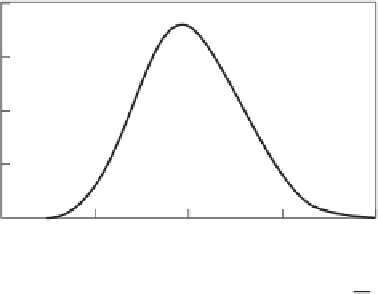Environmental Engineering Reference
In-Depth Information
0.8
0.6
0.4
0.2
0
0
1
2
3
4
V/ V
Figure 7.26
The probability of wave power per unit of relative wind speed
V
/
V
, as a function of relative
windspeed.
Most of the wave energy at a site is available only a small fraction of the time. Capacity factors
for practical wave energy systems are inevitably small, in the range 15-20%. This is unfavorable
to the economic viability of wave power and its suitability as a source of electrical power.
The most favorable sites for ocean wave power are the continental or island margins exposed
to prevailing winds. For mid- to high latitudes these winds are westerly, while for tropical latitudes
they blow from the east. At favorable locations, the annual average wave power available is about
50 kW/m. Because capacity factors are small for wave systems, the installed power at such locations
would be about 250 kW/m.
Many ingenious mechanisms have been proposed, and some of them tested, to produce me-
chanical or electrical power from wave systems. They are of two types: (a) floating bodies that
are anchored in place and (b) structures fixed to the sea bed. Mechanical power is produced by
the relative displacement of parts of the structure or by the flow of fluid within it, caused by the
impingement of waves on the device. The power that is produced is a fraction of the power available
in the waves that are intercepted by the device.
One of the devices, which has been tested to confirm a high efficiency of wave power con-
version, is illustrated in Figure 7.25(b). Called the Salter cam, the device consists of a horizontal
cylindrical float, of asymmetrical cross section shown in Figure 7.25(b), that in still water floats
with most of its volume below the sea surface. When waves impinge on the float, it rotates about a
stationary circular spline in an oscillatory manner. An electrical power system applies a restraining
torque to the float that absorbs most of the power in the incident wave system. The cam structure
must have dimensions greater than the wave height, and be tuned to the average wave frequency,
of the waves corresponding to its power capacity. In effect, the volume of the device will be
proportional to its rated power.
An ocean wave system carries momentum as well as energy. If the wave energy is absorbed
by a wave power system, a horizontal force per unit length will be exerted on the power system
of amount equal to the energy per unit surface area, equations (7.20) and (7.24). A corresponding
restraining force must be supplied by the anchoring gear that holds the power system in place.
The construction and operation of wave power systems immediately seaward of the ocean
shorefront would have some adverse environmental impacts. They must be anchored to the sea
bottom, disturbing some part of it. They may impede navigation and recreational use of the ocean
front, and they definitely would have aesthetic drawbacks.

